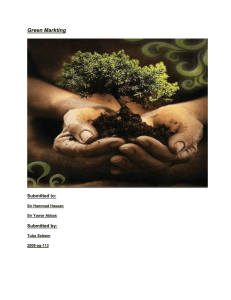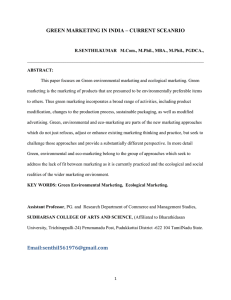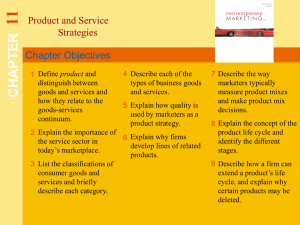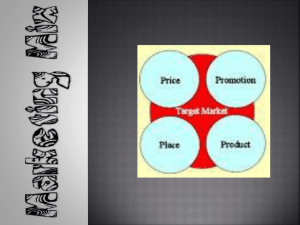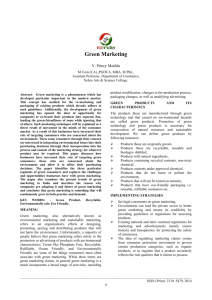Green Marketing
advertisement
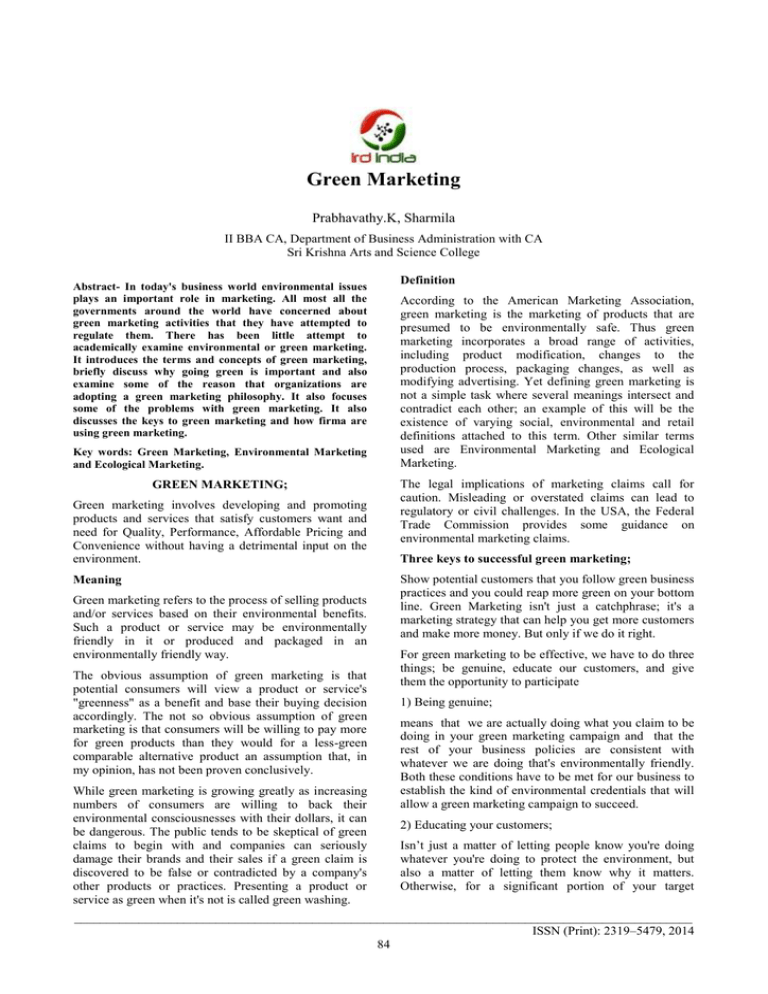
International Journal of Research and Development - A Management Review (IJRDMR) ________________________________________________________________________________________________ Green Marketing Prabhavathy.K, Sharmila II BBA CA, Department of Business Administration with CA Sri Krishna Arts and Science College Abstract- In today's business world environmental issues plays an important role in marketing. All most all the governments around the world have concerned about green marketing activities that they have attempted to regulate them. There has been little attempt to academically examine environmental or green marketing. It introduces the terms and concepts of green marketing, briefly discuss why going green is important and also examine some of the reason that organizations are adopting a green marketing philosophy. It also focuses some of the problems with green marketing. It also discusses the keys to green marketing and how firma are using green marketing. Key words: Green Marketing, Environmental Marketing and Ecological Marketing. GREEN MARKETING; Green marketing involves developing and promoting products and services that satisfy customers want and need for Quality, Performance, Affordable Pricing and Convenience without having a detrimental input on the environment. Meaning Green marketing refers to the process of selling products and/or services based on their environmental benefits. Such a product or service may be environmentally friendly in it or produced and packaged in an environmentally friendly way. The obvious assumption of green marketing is that potential consumers will view a product or service's "greenness" as a benefit and base their buying decision accordingly. The not so obvious assumption of green marketing is that consumers will be willing to pay more for green products than they would for a less-green comparable alternative product an assumption that, in my opinion, has not been proven conclusively. While green marketing is growing greatly as increasing numbers of consumers are willing to back their environmental consciousnesses with their dollars, it can be dangerous. The public tends to be skeptical of green claims to begin with and companies can seriously damage their brands and their sales if a green claim is discovered to be false or contradicted by a company's other products or practices. Presenting a product or service as green when it's not is called green washing. Definition According to the American Marketing Association, green marketing is the marketing of products that are presumed to be environmentally safe. Thus green marketing incorporates a broad range of activities, including product modification, changes to the production process, packaging changes, as well as modifying advertising. Yet defining green marketing is not a simple task where several meanings intersect and contradict each other; an example of this will be the existence of varying social, environmental and retail definitions attached to this term. Other similar terms used are Environmental Marketing and Ecological Marketing. The legal implications of marketing claims call for caution. Misleading or overstated claims can lead to regulatory or civil challenges. In the USA, the Federal Trade Commission provides some guidance on environmental marketing claims. Three keys to successful green marketing; Show potential customers that you follow green business practices and you could reap more green on your bottom line. Green Marketing isn't just a catchphrase; it's a marketing strategy that can help you get more customers and make more money. But only if we do it right. For green marketing to be effective, we have to do three things; be genuine, educate our customers, and give them the opportunity to participate 1) Being genuine; means that we are actually doing what you claim to be doing in your green marketing campaign and that the rest of your business policies are consistent with whatever we are doing that's environmentally friendly. Both these conditions have to be met for our business to establish the kind of environmental credentials that will allow a green marketing campaign to succeed. 2) Educating your customers; Isn’t just a matter of letting people know you're doing whatever you're doing to protect the environment, but also a matter of letting them know why it matters. Otherwise, for a significant portion of your target ________________________________________________________________________________________________ ISSN (Print): 2319–5479, 2014 84 International Journal of Research and Development - A Management Review (IJRDMR) ________________________________________________________________________________________________ market, it's a case of "So what?" and your green marketing campaign goes nowhere. 3) Giving your customers an opportunity; To participate means personalizing the benefits of your environmentally friendly actions, normally through letting the customer take part in positive environmental action. Evolution of Green Marketing; The green marketing has evolved over a period of time. According to Pattie (2001), the evolution of green marketing has three phases. First phase was termed as "Ecological" green marketing, and during this period all marketing activities were concerned to help environment problems and provide remedies for environmental problems. Second phase was "Environmental" green marketing and the focus shifted on clean technology that involved designing of innovative new products, which take care of pollution and waste issues. Third phase was "Sustainable" green marketing. It came into prominence in the late 1990s and early 2000. Why Green Marketing; As resources are limited and human wants are unlimited, it is important for the marketers to utilize the resources efficiently without waste as well as to achieve the organization's objective. So green marketing is inevitable. There is growing interest among the consumers all over the world regarding protection of environment. Worldwide evidence indicates people are concerned about the environment and are changing their behavior. As a result of this, green marketing has emerged which speaks for growing market for sustainable and socially responsible products and services. Benefits of Green Marketing; Companies that develop new and improved products and services with environment inputs in mind give themselves access to new markets, increase their profit sustainability, and enjoy a competitive advantage over the companies which are not concerned for the environment. Environmentally responsible or "green" marketing refers to the satisfaction of consumer needs, wants, and desires in conjunction with the preservation and conservation of the natural environment. Considered an oxymoron by many environmentalists (because it still promotes consumption, albeit so called responsible consumption), green marketing manipulates the four elements of the marketing mix (product, price, promotion, and distribution) to sell products and services offering superior environmental benefits in the form of reduced waste, increased energy efficiency, and decreased release of toxic emissions. These benefits are frequently estimated using life-cycle analysis (LCA) studies, which measure the environmental impact of products over their entire life cycle resource extraction, refining, manufacturing, transportation, use, and disposal. Green consumerism is based on public awareness of pressing environmental issues. Green marketers hope to capitalize on this by developing strategies that allow consumers to integrate green products into their lifestyles. Many such efforts by green marketers have met with considerable success. The "organic" industry, for example, which specializes in the sale of organically, based foods, health and nutritional products, and other green lifestyle items, saw its sales boom in the 1990s, from $1 billion in 1991 to $3.3 billion in 1996. Beginnings of environmentalism; Environmental concern in the United States has ebbed and flowed with the times. The first wave of environmentalism began in the late 19th century and was hallmarked by the preservationist-conservationist debates between naturalist John Muir (1838-1914) and Gifford Pinchot (1865-1946), the first chief of the U.S. Forest Service. All of these definitions enlarge the traditional objective of business to maximize profits by including some notion of maintaining the integrity of the natural environment. Operationally, green marketing seeks to satisfy the needs and wants of individual consumers while simultaneously seeking to improve environmental quality of life for society as a whole. Environmental concerns thus act as constraints on business operations, echoing a passage from the Great Law of the Iroquois Confederacy: "In our every deliberation, we must consider the impact of our decisions on the next seven generations." The greening of business; A number of factors have caused business firms to behave more responsibly towards the natural environment. Perhaps foremost among these is the possibility of capitalizing on opportunities from the sale of environmental services and “earth ECO-LABELING. ECO-LABELING; Environmental certification or labeling programs attempt to increase consumer awareness and knowledge of environmental issues. Marketers use eco-labels to convey information about a product's environmental benefits and to differentiate among competing products. Eco-labels may identify a product's contents, e.g. the triangular arrangement of arrows on recycled paper and plastic products, or highlight other benefits. ________________________________________________________________________________________________ ISSN (Print): 2319–5479, 2014 85 International Journal of Research and Development - A Management Review (IJRDMR) ________________________________________________________________________________________________ For instance, a product may have particularly low pollutant or noise emissions, entail less waste in its production, or are designed for easier recycling than its competitors. The Blue Angel has proven to be a useful selling tool in Germany's ecologically conscious society. A few other countries have established eco-labels, though none has yet had as great an impact as the Blue Angel. Eco-labeling programs increase awareness of environmental issues, set high standards for firms to work towards, and help reduce consumer uncertainty regarding a product's environmental benefits. ECO-SPONSORING; Another avenue for companies to promote their ecological concern is to affiliate themselves with groups or projects engaged in environmental improvements. In its simplest form, firms contribute funds directly to an environmental organization to further the organization's objectives. Another approach is to "adopt" a particular environmental cause, a community recycling program, demonstrating the company's willingness to put its money and its reputation on the line. Sponsoring educational programs, wildlife refuges, and clean-up efforts communicates a firm's commitment to finding environmental solutions. Partnerships with environmental organizations can open lines of communication and provide new perspectives on "business as usual. The EPA, for sponsors the Energy Star and Green Lights Buildings programs, in which partners in industry agree to upgrade their facilities over time to reflect environmental concerns (usually energy efficiency and waste minimization). The EPA, in turn, agrees to provide technical support and labeling, which contributes to a green marketing program. In considering an eco-sponsorship, firms must address the problems of legitimacy and believability. Not all environmental sponsorships are legitimate or appropriate for a particular company's needs. Chemical firms, for instance, may find it difficult to support Greenpeace's anti-chlorine campaign. Believability is even more critical. Business firms consistently rate lowest in surveys of credibility with consumers. Eco sponsoring should not be used as an alibi for a firm's day-to-day actions. Importance; The main idea behind green marketing has been re-marketing of products that are already manufactured, ________________________________________________________________________________________________ ISSN (Print): 2319–5479, 2014 86 International Journal of Research and Development - A Management Review (IJRDMR) ________________________________________________________________________________________________ which adhere to certain environmental guidelines. There has been a huge hue and cry from various environmental organizations about the damage caused to the planet by large scale production industries, and the inappropriate disposal methods they use. Having looked into these accusations, the government has imposed different agreements and guidelines on production units. Some business organizations have used it to their advantage, by openly campaigning for the cause, hence gaining the support of customers. However, some critics claim that this is just an advertising stunt to promote business, and that no real steps have been taken towards the cause. There is growing interest among the consumers all over the world regarding protection of environment. Worldwide evidence indicates people are concerned about the environment and are changing their behavior. As a result of this, green marketing has emerged which speaks for growing market for sustainable and socially responsible products and services. STRATEGY AND TACTICS 1. Green marketing as a sub discipline is only a few decades old, and much remains to be learned about consumer preferences, product substitutions, and environmental tradeoffs. Nonetheless, a few principles useful in developing a green marketing strategy have emerged. 2. Perhaps most obviously, the more recognizable the "green credentials," the greater the chances of a successful marketing campaign. A green product that properly addresses a well-known environmental issue of prominent concern, or that displays a well-established and respected eco-seal, will be more likely to win favor among green consumers. 3. Governments are increasingly adopting the "polluter pays" principle, establishing environmental liability for manufacturers and businesses engaged in polluting activities. Neither environmental legislation nor waste cleanup costs are likely to decrease in the coming decades, suggesting that a proactive strategy aimed at reducing waste and pollution at the source will yield both financial and environmental benefits. Indeed, pollution prevention is recommended by the U.S. Environmental Protection Agency as the most appropriate course of action for dealing with environmental problems. 4. The so-called principle of cooperation advises marketers to interact more closely with communities and governments in addressing environmental problems and communicating their respective expectations and concerns. Failure to work together on a voluntary basis may lead to additional regulations and requirements. 5. Numerous product success stories are associated with the implementation of these strategies. Lowphosphate detergents, CFC-free refrigerators, highefficiency light bulbs, low-emissions gasoline, lighter-weight packaging, powder paint sprays, and high-quality clothing made from recycled soda bottles are among many examples which might be mentioned. Partnerships between environmental groups and business organizations, such as the Environmental Defense Fund's work with the McDonald's restaurant chain, have increased communication and fostered better understanding of each group's objectives. Advantages; Advantages with the proliferation of environmental stories in the press and broadcast media, individuals (whether as a consumer or acting for a company), are more aware of their personal responsibility to try to make a difference. Appealing to this need can increase response rates to marketing executions and build brand loyalty. Promote for the better to customer As marketing actors should give the best to customers, by making green marketing strategy. For the better to consumers could mean provide packaging that can support surrounding environment or it could be if we have a food product we can pay more attention to consumer health impacts. With more attention to that, we have given something better than other products and it can make we more stand out in front of the customer. As said by Carrie Walsh, Our customers are consumers who care about their personal health and planetary health” More attractive products with green Doing a green marketing makes you different from the others, and this is will make its own interest to your product. However, implementing green marketing is certainly not easy, for the first you must know surefire steps that lead you to green marketing. Adoption of Green Marketing; There are basically five reasons for which a marketer should go for the adoption of green marketing. They are Opportunities or competitive advantage Corporate social responsibilities (CSR) Government pressure Competitive pressure Cost or profit issues Green Marketing Mix: Every company has its own favorite marketing mix. Some have 4P's and some have 7P's of marketing mix. The 4 P's of green marketing are that of a conventional marketing but the challenge before marketers is to use 4 P's in an innovative manner. Product: The ecological objectives in planning products are to reduce resource consumption and pollution and to ________________________________________________________________________________________________ ISSN (Print): 2319–5479, 2014 87 International Journal of Research and Development - A Management Review (IJRDMR) ________________________________________________________________________________________________ increase conservation of scarce resources (Keller man, 1978). Price: Price is a critical and important factor of green marketing mix. Most consumers will only be prepared to pay additional value if there is a perception of extra product value. This value may be improved performance, function, design, visual appeal, or taste. Green marketing should take all these facts into consideration while charging a premium price. Promotion: There are three types of green advertising: Ads that address a relationship between a product/service and the biophysical environment Those that promote a green highlighting a product or service Ads that present a corporate environmental responsibility lifestyle by image of Place: The choice of where and when to make a product available will have significant impact on the customers. Very few customers will go out of their way to buy green products. After-the-fact expenditures on pollution control and remediation are included, albeit as income. Greener pricing decisions are based on the premise that goods and services associated with greater environmental damage should cost more. Research conducted by the Roper Organization in 1990 identified five different groups of environmental consumers with varying degrees of commitment to purchasing environmental products. The premium on a product's price tag people were willing to pay for perceived environmental benefits varied widely from about 3 percent for the least-committed group to approximately 20 percent for individuals espousing the highest level of commitment. Across the board, consumers indicated a willingness to pay an average premium of approximately 6.6 percent for products with positive environmental attributes. Attitudes do not always translate into action, of course, but environmental attributes do seem to be "tiebreakers" for customers faced with a choice between two products offering similar benefits and prices. Green promotion; Marketing Audit (including internal and external situation analysis) Develop a marketing plan outlining strategies with regard to 4 P's Perhaps no area of green marketing has received as much attention as promotion. In fact, green advertising claims grew so rapidly during the late 1980s that the Federal Trade Commission (FTC) issued guidelines to help reduce consumer confusion and prevent the false or misleading use of terms such as "recyclable," "degradable," and "environmentally friendly" in environmental advertising. Implement marketing strategies Greener distribution; Plan results evaluation Logistics and transportation costs are coming under greater scrutiny due to rising fuel prices, congested highways, and global-warming concerns. Package redesign for lighter weight and/or greater recyclability reduces waste while simultaneously reducing costs. In some countries, marketers must also consider two-way flows, as governments pass legislation requiring manufacturers to take back products at the end of their useful life ("reverse logistics"). Germany is again the world leader in this arena; it has already passed ordinances targeting the electronics, automobile, and packaging industries. Strategies: The marketing strategies for green marketing include: Culture: Traditional marketing attempts to identify and meet latent, current, or future consumer needs by manipulating the so-called four Ps: price, promotion, product, and place (distribution channels). These objectives have historically been identified with efforts to increase consumption of material goods and services, practices not particularly compatible with the notion of a sustainable society. Environmentalists have criticized various aspects of the consumption culture, particularly its wasteful and pollutive production and disposal processes. Managers should keep these critiques in mind when creating green marketing strategies. Green marketing can accommodate these concerns in a way that remains attractive to consumers by addressing the environmental and consumer advantages inherent in the product. Greener pricing; A central concern of many environmentalists is that product prices do not reflect total environmental costs. Waste disposal costs, for instance, are frequently incurred on a fixed-fee basis, regardless of how much waste is actually generated. Similarly, the national accounting systems of most countries do not incorporate the costs of environmental degradation or depletion. The FTC offers four environmental claims: general guidelines for 1. Qualifications and disclosures should be sufficiently clear and prominent to prevent deception. 2. Environmental claims should make clear whether they apply to the product, the package, or a component of either. Claims need to be qualified with regard to minor, incidental components of the product or package. 3. Environmental claims should not overstate the environmental attribute or benefit. Marketers ________________________________________________________________________________________________ ISSN (Print): 2319–5479, 2014 88 International Journal of Research and Development - A Management Review (IJRDMR) ________________________________________________________________________________________________ should avoid implying a significant environmental benefit where the benefit is, in fact, negligible. 4. A claim comparing the environmental attributes of one product with those of another product should make the basis for the comparison sufficiently clear and should be substantiated. WHY ARE FIRMS USING GREEN MARKETING; When looking through the literature there are several suggested reasons for firms increased use of Green Marketing. Five possible reasons cited are: 1. Organizations perceive environmental marketing to be an opportunity that can be used to achieve its objectives. 2. Organizations believe they have a moral obligation to be more socially responsible. 3. Governmental bodies are forcing firms to become more responsible. 4. Competitors’ environmental activities pressure firms to change their environmental marketing activities. 5. Cost factors associated with waste disposal, or reductions in material usage forces firms to modify their behavior. CNG in Delhi b. Coca-Cola pumped syrup directly from tank instead of plastic which saved 68 million pound year. c. Badarpur Thermal Power station of NTPC in Delhi is devising ways to utilize coal-ash that has been a major source of air and water pollution. d. Bahraini refinery of IOC is taken steps for restricting air and water pollutants. CONCLUSION Green marketing is based on the premise that businesses have a responsibility to satisfy human needs and desires while preserving the integrity of the natural environment. That this latter concern has been ignored throughout most of recorded human history does not mean it will be unimportant in the future. Indeed, there are significant indications that environmental issues will grow in importance over the coming years and will require imaginative and innovative redesign and reengineering of existing marketing efforts on the part of many businesses. REFERENCES: [1] J.A Ottman,. et al, "Avoiding Green Marketing Myopia",Environment, Vol-48, June2006 [2] http://www.grailresearch.com/pdf/Conten PodsPdf/TheGreenRevolution.pdf,(Accessed in 10 December 2010) New Delhi, capital of India, was being polluted at a very fast pace until Supreme Court of ndia forced a change to alternative fuels. In 2002, a directive was issued to completely adopt CNG in all public transport systems to curb pollution. a. McDonald's restaurant's napkins, bags are made of recycled paper. ________________________________________________________________________________________________ ISSN (Print): 2319–5479, 2014 89
